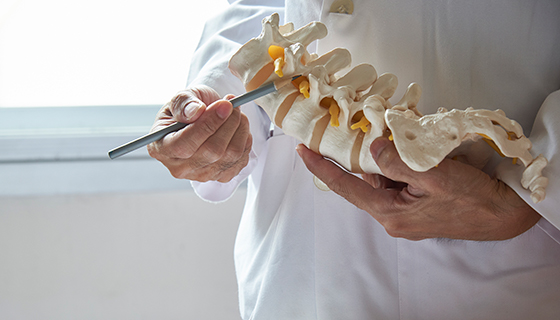Minimally Invasive Spinal Fusion
What is minimally invasive spinal fusion?
Spinal fusion is a surgical procedure to join 2 or more bones (vertebrae) of your spine together permanently. A minimally invasive spinal fusion uses a smaller cut (incision) than a traditional spinal fusion surgery.
Your vertebrae are the small bones that make up your spinal column. These vertebrae stack on top of each other. They are separated by intervertebral disks. These bones protect your delicate spinal cord, which sends and receives information from your brain to the rest of your body.
Various health conditions might cause your vertebrae to move against each other more than they should. This can stretch your surrounding nerves, ligaments, and muscles, causing pain. Spinal fusion may stop this pain by preventing 1 or more of your vertebrae from moving.
Depending on your problem, your surgeon might use different approaches to get to your vertebrae. For instance, with direct lateral interbody fusion, your surgeon accesses your vertebrae from your side. With transforaminal lumbar interbody fusion, your surgeon approaches your spine through your back. Your surgeon then places a graft of some sort (like bone) in the space between your vertebrae.
For minimally invasive spinal fusion, you’ll be given medicine (general anesthesia) to put you asleep. One or more small incisions will be made to access your spine. Your surgeon will gently push away the muscles of your back with a special tool. Your surgeon will then remove the cushion (disk) between the vertebrae to fuse. They will then weld together 2 or more of your vertebrae. They do this by placing bone or some other material such as titanium in the space where the disk was. In some cases the disks are left in place and the bone is fused on each side.
Minimally invasive spinal fusion uses smaller incisions than traditional surgery. Because of this, it may lead to faster recovery times than traditional surgery. It may also reduce the chance for certain problems.
Why might I need minimally invasive spinal fusion?
You might need spinal fusion for a variety of health conditions, such as:
-
Degenerative disc disease
-
Spinal stenosis
-
Spondylolisthesis
-
Scoliosis
-
Break (fracture) of your spinal column
-
Infection of your spinal column
-
Tumor in your spinal column
These conditions might be causing you major back pain. Your healthcare provider may want to try other more conservative treatments first, such as pain medicines and physical therapy. If these don’t work for you, minimally invasive spinal fusion may make sense. But spinal fusion can’t help all types of back pain. Your provider will advise it only if the procedure might work for you.
Talk with your healthcare provider about the risks and benefits of a minimally invasive spinal fusion, instead of a traditional one.
Spine Surgery Q&A with Hamid Hassanzadeh, M.D.
What are the risks of minimally invasive spinal fusion?
Most people do very well with their minimally invasive spinal fusion. But as with any surgery, the procedure does carry some risks. Possible risks include:
-
Infection
-
Too much bleeding
-
Lack of a solid bone fusion (nonunion or pseudarthrosis). This is a greater risk for people using nicotine products or people with diabetes.
-
Nerve damage
-
Blood clots
-
Need for more surgery
There is also a risk that your surgery will not effectively get rid of your pain. Or the surgery might cause a different type of persistent pain at the graft site.
One side effect of all spinal fusion surgeries is decreased flexibility of your spine. Usually, this limits motion only a small amount and isn’t a major problem in the short term. But after many years, it may lead to more stress on the nearby parts of your spine.
Your own risk for complications may vary based on your age, the surgical approach, the anatomy of your back problem, and your other health conditions. Ask your healthcare provider about the risks that most apply to you.
How do I get ready for minimally invasive spinal fusion?
Ask your healthcare provider how you should prepare for your surgery. Ask if you should stop taking any medicines ahead of time, like blood thinners. If you are a smoker, you should try to quit before your surgery. Follow any directions you are given for not eating or drinking before your procedure. Your provider may order more imaging tests of your spine before your surgery, such as an MRI.
Before surgery you will be asked to sign a document called an “informed consent.” This form gives the doctor permission to do your surgery. Signing it means you understand the risk and benefits of the surgery and know about other treatments options. It also states that any questions you have were answered to your satisfaction. Read the form carefully. Be sure all of your questions are answered before you sign it.
What happens during minimally invasive spinal fusion?
Your healthcare provider can help explain the details of your particular surgery. They will depend on the nature of your injury and the surgical approach. An orthopedic surgeon or neurosurgeon and a team of specialized nurses will do the surgery. The whole surgery may take a couple of hours. In general, you can expect the following:
-
You will be given anesthesia so that you’ll sleep and won’t feel any pain or discomfort during the surgery.
-
Your vital signs, like your heart rate and blood pressure, will be carefully watched during the surgery. You may have a breathing tube inserted down your throat during the surgery to help you breathe.
-
You may be given antibiotics during and after the procedure to help prevent infection.
-
Your surgeon will make a small incision, often on your side or back.
-
Using special tools, the surgeon will dilate your back muscles, pushing them out of the way.
-
Your surgeon will remove the intervertebral disk between your affected vertebrae.
-
They will place some sort of material in the space between your vertebrae. This might be bone or a synthetic bone-like material.
-
Your surgeon may use special screws or other material to anchor your bones in place.
-
Your surgeon will make other repairs, if needed.
-
The layers of skin around your incision will be surgically closed.
What happens after minimally invasive spinal fusion?
Talk with your healthcare provider about what you can expect after surgery. You may have some pain around your incision after the procedure. But you can take pain medicines to relieve it. You should be able to resume your normal diet and activities fairly quickly. You may have some sort of imaging procedures, like X-ray, done to see how your surgery went. Depending on the extent of your injury and your other health conditions, you might be able to go home within the next couple of days.
Your original symptoms may greatly decrease right after your surgery. Or they might go away more slowly.
Follow all your healthcare provider’s instructions carefully. They might not want you to take certain over-the-counter medicines for pain. Some of these can interfere with bone healing. Your provider may advise you to eat a diet high in calcium and vitamin D as your bone heals.
You might have a little drainage from your incision. This is normal. Let your healthcare provider know right away if you notice an increase in redness, swelling, or draining from your incision. You should also let them know if you have high fever, incision drainage that has a bad odor, or severe pain that is not improving. Make sure to keep all of your follow-up appointments. You may need to have your stitches removed a week or so after your surgery.
While you heal, it’s important to keep your spine in correct alignment. A healthcare provider will show you the correct way to move. At first, you’ll likely need to only do light activity, like walking. As you heal, you’ll be able to slowly increase your activity level.
Next steps
Before you agree to the test or the procedure make sure you know:
-
The name of the test or procedure
-
The reason you are having the test or procedure
-
What results to expect and what they mean
-
The risks and benefits of the test or procedure
-
What the possible side effects or complications are
-
When and where you are to have the test or procedure
-
Who will do the test or procedure and what that person’s qualifications are
-
What would happen if you did not have the test or procedure
-
Any alternative tests or procedures to think about
-
When and how will you get the results
-
Who to call after the test or procedure if you have questions or problems
-
How much will you have to pay for the test or procedure







